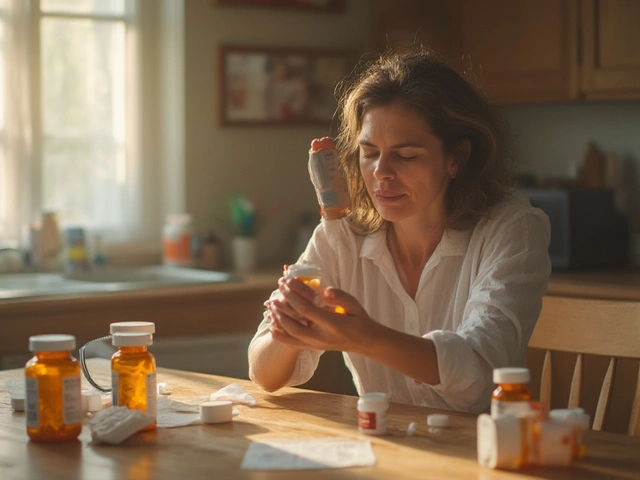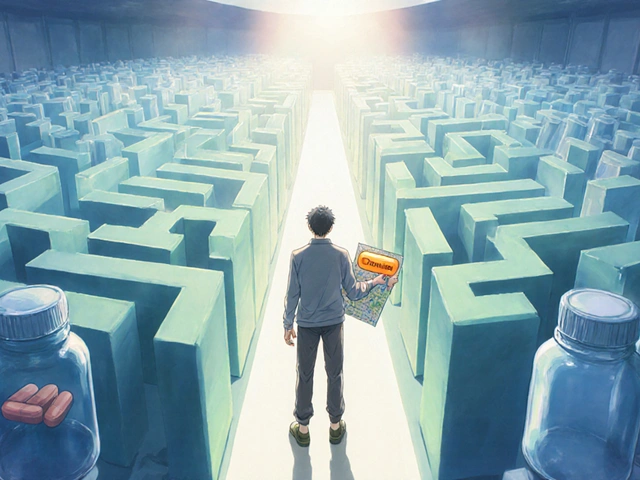The smallest pills sometimes bring the biggest relief. Celebrex sits on pharmacy shelves right next to dozens of other pain meds, but it quietly stands out—because it can mean the difference between a painful, stiff morning and one where you can actually open a jar or tie your shoes. If you've ever panicked over knee pain before a big vacation or watched your hands swell after typing, you've probably wished you had a plan. That's where Celebrex comes into the conversation for millions each year.
What is Celebrex and How Does it Work?
Celebrex, sold under the generic name celecoxib, belongs to a group of medications called NSAIDs (nonsteroidal anti-inflammatory drugs). But it’s not your typical ibuprofen or naproxen. Celebrex is special because it's designed to target inflammation in a slightly sneakier way. It’s a COX-2 inhibitor, which means it blocks a specific enzyme (cyclooxygenase-2) in your body that triggers swelling and pain, but leaves the COX-1 enzyme alone. That’s important, because blocking COX-1—the way traditional NSAIDs do—can cause stomach irritation and ulcers for a lot of folks.
This means taking Celebrex should, in theory, come with less risk of annoying stomach problems than the old-school painkillers you buy at the corner store. Don’t get me wrong, it’s not foolproof, but research has shown it’s gentler on the gut. The FDA gave Celebrex its green light in 1998, and it’s been prescribed to millions ever since for conditions like osteoarthritis, rheumatoid arthritis, ankylosing spondylitis, and even period cramps. Studies have found it works about as well as other NSAIDs for pain and swelling, but with a different risk profile—especially for the stomach.
If you’re the kind of person who likes numbers, here’s a quick comparison table that spells it out:
| Drug | Type | Main Enzyme Blocked | Common Uses | GI Risk |
|---|---|---|---|---|
| Celebrex | COX-2 Inhibitor | COX-2 | Arthritis, Pain, Menstrual Cramps | Lower |
| Ibuprofen | NSAID | COX-1 and COX-2 | Pain, Fever, Inflammation | Higher |
| Naproxen | NSAID | COX-1 and COX-2 | Pain, Arthritis, Menstrual Cramps | Higher |
But keep in mind, nothing is ever truly risk-free, and the way your body responds can be unpredictable. It's best to discuss any medication—especially Celebrex—fully with your doctor, since it’s not right for everyone. You'll hear people say, “Oh, it’s just like taking Tylenol.” Spoiler: it isn’t. Acetaminophen (Tylenol) isn't an NSAID. It doesn't have the same anti-inflammatory effect. That may sound like splitting hairs, but it can make a huge difference if your pain is coming from inflammation—like arthritis or an injury that just won't settle down.
Who Should (or Shouldn't) Take Celebrex?
Doctors reach for Celebrex when typical NSAIDs have left someone with heartburn, ulcers, or just won’t cut it. It’s a sound choice for chronic pain—especially osteoarthritis and rheumatoid arthritis, where people need consistency without wrecking their gut. Imagine trying to work a desk job with rheumatoid arthritis flaring every month; Celebrex can bring steady relief so you can live a pretty normal life.
But—and this is a big but—Celebrex doesn’t work for everyone, and there are people who shouldn’t touch it with a ten-foot pole. If you have an allergy to sulfa drugs (the kind found in some antibiotics and diuretics), your doc will steer clear since celecoxib is a sulfonamide. Same goes for people who’ve had a severe reaction to any NSAID. And if you have a history of heart attacks, strokes, or uncontrolled high blood pressure, Celebrex can raise your risk of cardiovascular problems. The science backs this up: back in the 2000s, questions about heart safety caused some COX-2 inhibitors to get pulled off the market. Celebrex stayed because data later showed its risks are lower, especially when taken in lower doses for the shortest time possible. Still, the FDA requires warnings on the packaging about possible heart risks.
If you’re dealing with liver or kidney disease, the plot thickens. Celebrex is processed through those organs, and taking it when they’re not working well can build up toxic levels in your system. The same goes for people who take certain heart or psychiatric meds; always double-check with your pharmacist for possible drug interactions. Grapefruit is usually a problem with some other drugs, but not with Celebrex—it’s not one of those. Here’s a quick tip if you deal with allergies: check the list of inactive ingredients since manufacturers sometimes change their formulas and fillers between brands or generics.
What about pregnant people? Up until 20 weeks, some docs will allow occasional use if the benefits outweigh the risks, but after that, there’s a real danger to the unborn baby (like kidney problems or decreased amniotic fluid). Anyone breastfeeding should mention it to their healthcare provider—it's not usually recommended, since it can pass into breastmilk in small amounts. Stay far away from Celebrex if you’re having elective surgery or dental work coming up, since it can affect blood clotting in some cases.

Proper Dosage, Best Practices, and How to Maximize Relief
If you’re handed a prescription for Celebrex, it’s tempting to think, “Just pop it whenever I need it.” Not so fast. Doctors usually tailor the dose to fit your specific condition and how your body reacts. For osteoarthritis, the standard is 200 mg a day, taken either as one dose or split into two. For rheumatoid arthritis, adults often start at 100 mg twice daily. For jumping-bad period pain, people may take a single dose at the very start of cramps, up to 400 mg for the first day, and then smaller amounts after.
The trick is to use the lowest dose that helps—don’t ramp up the milligrams just because you think more is better. That logic can backfire, increasing the risk of heart or stomach issues. Always swallow the capsule whole with a full glass of water; don’t chew, crush, or open them. Some take it with food if they’re prone to stomach sensitivity, but the absorption isn’t much different either way. Try to take it at the same time(s) each day, so you can keep steady levels in your system. Set a phone reminder if you’re forgetful, or keep your bottle where you’ll see it, like next to your toothbrush.
Keep an eye on expiry dates, since old NSAIDs can lose potency or irritate your stomach more. If you miss a dose, just take the next one at your regular time—don’t double up. Here’s a pro-tip that real patients use: keep a medicine journal. Jot down when you take your dose, any side effects or flare-ups, and note diet changes or extra activity. Over time, this record helps spot patterns and gives your doctor real info instead of guesswork.
Keep in mind, pain meds like Celebrex only treat symptoms, not the root problem. If you’re stiff and sore every morning, talk with your doctor about other strategies, like physical therapy, stretching, or even changing up your workspace. Sometimes combining Celebrex with acetaminophen is okay if you need a little oomph for breakthrough pain, but always clear this combo by your provider to avoid risks.
If you have trouble remembering if you took your dose, use a weekly pill sorter. Don’t mix up your Celebrex with similar-looking meds—label everything during busy weeks. For those traveling, keep your prescription bottle on hand at airport checkpoints. Plan ahead if you need a refill, because pharmacies sometimes run shortages, and skipping doses can set your recovery back.
Common Side Effects, Safety Tips, and What to Watch Out For
So what’s the catch? Celebrex almost sounds too good to be true—a painkiller that doesn’t wreck your stomach. But even with a better safety record, side effects still happen. The most common stuff people run into is usually mild: an upset stomach, heartburn, diarrhea, or gas. Some report headache or dizziness, so go easy your first few days on it—don’t plan that mountain hike right away.
But there’s a darker side if you push doses or mix Celebrex with other blood thinners. Watch for warning signs like black tarry stools, unusual bruising, or coughing up anything that looks like coffee grounds. Chest pain, sudden leg swelling, slurred speech, or shortness of breath calls for a trip to the ER. Most people will never see these serious side effects, but it happens often enough that you shouldn’t ignore early red flags. Trust your gut. And if you feel ‘off’ or notice facial swelling, a rash, or trouble breathing, stop the drug immediately and call your doctor.
Drug interactions are a whole topic of their own. Common ones to avoid include: blood pressure meds called ACE inhibitors (like lisinopril), water pills (diuretics), lithium (used for mood disorders), and certain antidepressants. Mixing multiple NSAIDs at once—say, ibuprofen for headaches on top of Celebrex for arthritis—is a giant no-no. One at a time, please. Even alcohol deserves a mention; mixing daily drinking with NSAIDs, including Celebrex, can magnify stomach and liver risks.
If you’re into supplements, double-check that you’re not overloading on fish oil (which thins blood) or herbal anti-inflammatories unless a healthcare provider OKs it. Keep a current list of your meds (including vitamins) in your purse or on your phone. You never know when you’ll be at urgent care and your memory blanks on the spot. Here’s a fast way to check if you’re ready to start or continue Celebrex:
- Are your kidney and liver numbers normal on recent blood tests?
- Any history of heart attack, stroke, stomach bleeding, or ulcers?
- Are you already on any blood thinners, diuretics, or mood-stabilizing meds?
- Any allergies to sulfa drugs or previous bad reactions to NSAIDs?
- Are you pregnant, breastfeeding, or planning surgery soon?
If you hit yes on any of the above, circle back with your doctor.
One last tidbit: if you’re over 65 or taking Celebrex for a long haul, schedule regular checkups. Your body doesn’t bounce back the same way it did in your twenties, and risks of side effects increase with age and chronic use. Lab work can catch brewing problems you can't see or feel.
So, Celebrex isn’t magic—but for people plagued by chronic pain, it’s a real lifeline. Use it wisely, and it can help keep you doing what you love, minus the hassle of constant discomfort. Celebrex won’t fix everything, but when used well, it could mean the difference between making memories and sitting life out. Always talk to your provider and weigh your options with real, honest information. The right treatment lets you get back to living on your terms—without your pain calling the shots.









Ellie Haynal
July 17, 2025 AT 23:20Wow, this Celebrex article really hits the nail on the head about its usefulness and potential risks. I’ve seen too many people rushed into taking meds without any clear understanding of the side effects. It’s refreshing to see an in-depth explanation that doesn’t gloss over the serious stuff.
Honestly, if you ask me, too many doctors just prescribe it like candy without discussing heart risks or stomach issues linked with NSAIDs like Celebrex.
Plus, the fact that it’s used widely for arthritis, which is such a painful and long-lasting condition, means that patients should be cautious but also hopeful. We really need more of these practical guides to empower people before they go in for a prescription.
Has anyone here had personal experience with Celebrex for arthritis pain? What were your side effects, if any? I feel like sharing real stories would add even more value to this conversation.
Jimmy Gammell
July 21, 2025 AT 16:13This post is really helpful for people who might be feeling lost when doctors mention Celebrex. Sometimes it’s hard to keep track of what the meds do and whether they are safe.
I like that it includes practical tips and facts, because at the end of the day, understanding the medication helps us to be more responsible with how we take it. Plus, knowing the common side effects upfront helps people catch problems early and get help.
Good post, thanks for sharing. Hope this helps many out there. :)
fred warner
July 25, 2025 AT 18:00From my experience, Celebrex is quite effective for reducing inflammation and pain in arthritis patients, but it's crucial to emphasize it should be taken exactly as prescribed.
The article's mention of dosage is spot on; many underestimate the importance of following the recommended dose to avoid side effects, some of which can be serious like cardiovascular events.
What I encourage everyone is to keep an open line with your healthcare provider and report any unusual symptoms immediately.
Also, do not combine it with other NSAIDs without medical advice, because the risks can multiply.
Overall, a comprehensive overview — this kind of knowledge can save lives.
Veronica Mayfair
July 29, 2025 AT 20:26Ahmazing article! 😍 I’m always scared to try new meds, but this one made Celebrex seem so reachable and safe when handled properly! 😊✨
The tips about watching for side effects are super important because sometimes folks just overlook minor symptoms like a stomach ache or dizziness, which could be warning signs.
Did anyone else here find it hard to get info from their doc about Celebrex? I swear doctors sometimes rush through the explanation, but resources like this really fill the knowledge gap. 👏👏
Glad to see a medical article that actually feels warm and understanding instead of cold and clinical. Thank you for sharing!
Rahul Kr
August 2, 2025 AT 14:13This post is quite informative and laid out nicely. Having worked in a medical environment, I can say that meds like Celebrex are a blessing but only when patients understand their limits.
The guidelines on how to use the med safely are crucial and often neglected.
I'd add that lifestyle changes like diet and gentle exercise complement the effectiveness of Celebrex and sometimes reduce the needed dosage.
Keeping a journal of symptoms while on Celebrex can help your doctor adjust treatment and should be encouraged.
Thanks for the detailed write-up — good read!
Joshua Logronio
August 5, 2025 AT 21:53Honestly, there's so much hype around medicines like Celebrex. Makes me wonder if the big pharma giants and their shady deals push these drugs on us just to rake in profits. 😒
Sure, it's helpful for pain relief but what about the long-term hidden effects they don't talk about? Are we really getting the full story? I've seen too many cases where people ended up worse after relying too much on one pill.
Still, this article does tip into the side effects, which is good. But trust no one blindly — always do your homework.
Anyone else think these meds come with more strings attached than presented?
Anthony Coppedge
August 10, 2025 AT 07:26The explanation here is quite clear, especially regarding dosage and side effects. I appreciate that the article suggests talking to your doctor first since self-medicating with Celebrex could be dangerous.
What stood out to me is the emphasis on understanding the medication mechanism — it helps set expectations about how quickly you might feel relief.
Some people underestimate the importance of adhering to guidelines, and that can lead to severe gastrointestinal or cardiac complications.
My only critique is that it might have included more on interactions with other drugs, since polypharmacy is common in older adults.
Otherwise, a very solid article.
Suzanne Podany
August 13, 2025 AT 07:40This is a valuable resource! I work with many patients who are nervous about starting Celebrex, so having clear info helps them make informed decisions.
One tip I often give is to watch for both common side effects like stomach upset and the less frequent but serious ones such as chest pain or shortness of breath.
Education like this empowers patients to seek help without delay if problems arise.
Great to see a compassionate approach that balances benefits and risks accurately.
Thanks for posting!
Steve Ellis
August 14, 2025 AT 11:26I'm totally on board with the comments about cautious use. Pain meds can be lifesavers but also dangerous if misused.
I've coached a few friends through managing arthritis pain, and Celebrex always comes up as a recommended option.
What I emphasize is keeping a close watch on any new symptoms and not to be shy about telling your doctor about them.
Besides that, maintaining a holistic approach with diet and exercise has been really crucial for pain management.
Anyone else here combine Celebrex with other treatments successfully?
Lindsey Bollig
August 15, 2025 AT 15:13I really appreciate how this article doesn’t sugarcoat the potential risks with Celebrex. It’s tempting to just want quick relief and forget about side effects. But being informed helps us make smarter choices.
One thing I would add is consult about any history of cardiovascular disease before starting this med, as the article hints at but doesn’t extensively cover.
Also, always review your full medication list with the doc to avoid interactions.
Good on you for compiling a well-rounded resource!
Daniel Buchanan
August 16, 2025 AT 02:20This thread and article make such an important contribution! The approach taken here is respectful of patients’ need for clear, understandable info.
It can be overwhelming navigating all the medication options out there, so posts like this cut through confusion.
One subtle point that could be stressed more is the need for ongoing monitoring when on Celebrex, including regular check-ups for kidney and heart function especially for older adults.
Thanks to everyone who contributes such thoughtful insights here.